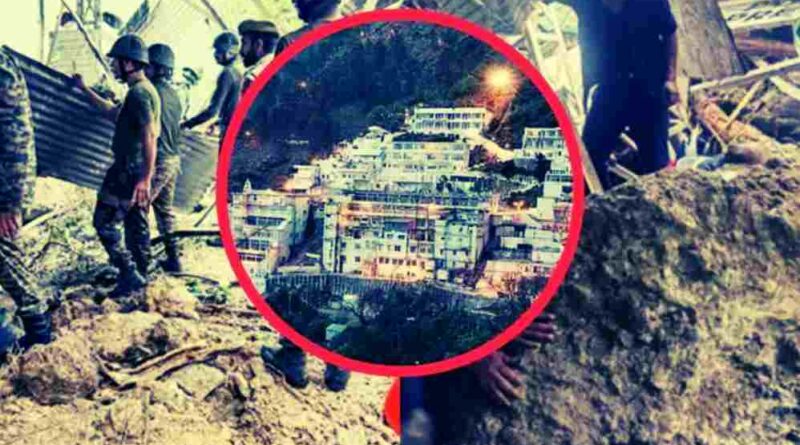Tragedy Strikes Mata Vaishno Devi Pilgrimage as Landslide Claims Lives
The spiritual journey to Mata Vaishno Devi, one of India’s most revered shrines, turned into a scene of devastation on August 26, 2025. Heavy monsoon rains triggered a massive landslide along the pilgrimage route, leaving at least five devotees dead and more than a dozen others injured.
The incident took place near Adhkwari, a mid-point on the 12-kilometer uphill trek to the sacred cave shrine in Jammu and Kashmir’s Trikuta Hills. Thousands of pilgrims who had gathered with devotion and faith suddenly found themselves caught in chaos as rocks and mud came crashing down.
A Pilgrimage Interrupted
The Vaishno Devi Yatra is not just a religious ritual—it is an emotional and spiritual experience for millions each year. Families, elderly devotees, and young travelers alike brave the steep climbs, chanting hymns, with each step symbolizing faith and perseverance.
On this day, however, that sacred climb came to an abrupt halt. Around mid-afternoon, as rains intensified, authorities were forced to suspend the pilgrimage. First, the Himkoti route was shut down, and shortly after, the older and more traditional track was also closed. By 3 p.m., the landslide had struck, and parts of the pathway were left buried under mud and boulders.
Rescue Efforts Amidst Rains
Eyewitnesses describe moments of panic—pilgrims running for shelter, cries for help echoing through the valley, and stunned silence as debris blocked the sacred path. Within minutes, rescue operations were launched.
Teams from the Central Reserve Police Force, the Army, and the local administration rushed to the site. Emergency medical units were deployed, and injured pilgrims were shifted to nearby hospitals. Despite the rain, heavy machinery was brought in to clear the debris and search for survivors.
Officials confirmed that at least five people lost their lives, and 14 others were left injured in the incident. Many of the injured remain in critical condition, highlighting the ferocity of the landslide.
The Wider Impact of Monsoon Fury
The disaster at Vaishno Devi is part of a larger weather crisis unfolding across Jammu and Kashmir. Continuous rainfall has led to flash floods, landslides, and widespread disruption.
- Transport hit hard: Over a dozen trains had to be canceled, with railway tracks washed away or blocked by debris in several areas. Road networks connecting key towns were damaged, making access to the shrine even more challenging.
- Communication breakdown: Mobile and internet services in several districts were disrupted as fiber lines were damaged. Pilgrims and locals alike found themselves unable to connect with families, intensifying the fear and uncertainty.
- Schools and offices closed: With safety at risk, educational institutions were shut down, and recruitment exams were postponed. Life across the region slowed as people braced for further weather warnings.
The Meteorological Department has already issued alerts for more heavy rainfall, flash floods, and landslide risks, urging people to avoid unnecessary travel to vulnerable zones.
A Test of Faith and Resilience
The Mata Vaishno Devi Yatra has stood for centuries as a symbol of unwavering faith. Pilgrims undertake the journey despite physical strain, unpredictable weather, and steep climbs, believing that reaching the shrine brings blessings, peace, and strength.
Yet, this tragedy is a harsh reminder that while faith gives courage, nature has its own untamable power. For the families who lost loved ones, the climb meant to bring spiritual fulfillment has instead brought grief and heartbreak.
Even as prayers pour in from across the country, questions arise about the safety measures on such vulnerable routes. Should there be more preventive infrastructure, better early-warning systems, and stricter monitoring of weather conditions before allowing the yatra to continue?
Moving Forward
In times like these, collective empathy becomes as important as rescue and relief. Local authorities continue to clear the path, but the psychological wounds of survivors and families will take far longer to heal.
The tragedy at Vaishno Devi is not just a regional event—it resonates nationally. For a country where faith and spirituality run deep in daily life, seeing a pilgrimage turn into a disaster shakes hearts everywhere.
It is a moment to reflect on the balance between devotion and preparedness. Faith can move mountains, but preparedness can save lives when mountains move.
Closing Thoughts
The landslide at Vaishno Devi is more than just a natural disaster—it is a story of devotion meeting nature’s fury, of families torn apart in the pursuit of blessings, and of resilience in the face of grief.
As authorities work tirelessly to restore the pilgrimage route and safeguard future yatras, one truth stands clear: the hills that cradle faith must also be treated with the respect and caution nature demands.
For now, the prayers of millions across the country are with the departed souls and the survivors. And with time, the sacred path to Mata Vaishno Devi will once again echo with chants of faith—but this tragedy will serve as a somber reminder of the fragile thread that binds human journeys with the forces of nature.
Disclaimer
The information and content shared on digitalgithub.com — including articles, blogs, news, guides, and other resources — is intended for general informational and educational purposes only. We do not guarantee the completeness, reliability, or suitability of any information. Always seek the guidance of a qualified professional before making decisions based on the information you read. Use this site at your own risk.

